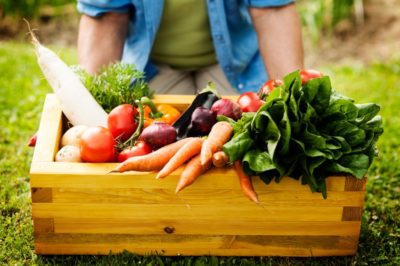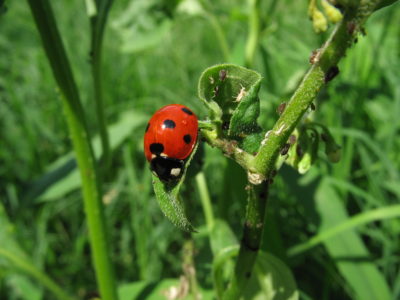|
Listen To The Article
|
 Beginning a new vegetable garden does not mean that one has to live on a large plot of land. Vegetable gardens are possible and doable in sectioned off backyards, and even in potted gardens kept on window sills and porches. When one decides to begin a garden, he or she should determine how much land is available for growing, what type of soil is needed, and what vegetables will grow in the existing climate.
Beginning a new vegetable garden does not mean that one has to live on a large plot of land. Vegetable gardens are possible and doable in sectioned off backyards, and even in potted gardens kept on window sills and porches. When one decides to begin a garden, he or she should determine how much land is available for growing, what type of soil is needed, and what vegetables will grow in the existing climate.
1. The Foundation of a Good Garden – The Soil
The first step to caring for a garden is to know what type of soil the vegetables should be planted in. Not all soil is fit for growing edible foods. Poor soil either has too many nutrients and will damage the plant as it grows, the wrong pH balance, or too few nutrients. These issues can be corrected by adding in different types of fertilizer.
If the problem happens to be that the soil is too sandy or composed of too much clay, there are solutions for that as well. Sandy soil can be thickened to help hold root growth by adding in peat moss. This will make the upper layer of sand better able to hold on to the roots of young shoots.
Manure and other organic matter will also help to bind the soil while adding in nutrients as well. Compost is a great way to recycle food scraps and other biodegradable debris and is a good addition to garden soil. One must be careful with compost because it is easy to add this product in quantities that can quickly become harmful to young plants.
It is now time to test the pH of the soil. An easy method is through a soil testing kit that can be purchased from any gardening supply store. If it is on the acidic side, then a gardener can add ground limestone to the soil. This will bring the pH balance closer to 6.5 – which is the best pH environment for plant growth. If the soil pH is higher than that, then to lower it one needs only to add items that carry a heavy amount of acidic qualities. These can include peat moss and even sawdust.
Order your 2014 Heirloom Solutions seed catalog and get $20 in your account!
Evening out the type of soil and the pH levels now makes it possible to grow a variety of plants. Climate conditions and season will determine which plants can be grown. Some plants thrive more in warm climate conditions, such as tomatoes and snap peas. Others are suited to grow in either a warm or cool climate, such as leeks and garlic. These plants can grow in the autumn and even into or throughout the winter. Growing the wrong plant in the wrong environment can stop a garden before it even begins.
2. Planting and Watering
When planting is to start, the gardener needs to first till the soil. This will loosen the particles so that air will be easily accessible to seeds. Plants get their oxygen from the soil through their root system and compacted soil is a barrier to their oxygen needs. (This is also the reason plants can “drown” if overwatered.) Different plants need varying amounts of sunlight and space to grow. Most seed packets will tell a gardener how deep into the soil they should plant the vegetable and how much space they should give it. It will also instruct on the amount and frequency of watering the plant will need.
Some places have enough precipitation to water plants without the interference of the gardener, but if that is not the case, the gardener will need to look into irrigation methods suitable to the size of his or her garden. If the garden is about an acre, it will require a sprinkler system. If it is a few square feet of property in the backyard, a large watering can or a hose with a spray nozzle will suffice.
3. Working with the Sunlight You Have
After the garden is planted, the concerns left to the gardener are sun control, insects, plant diseases, and weeds. In order to control how much sun a specific type plant will receive, the location of choice in the garden can be one of the best problem solvers. If plants need more shade, the garden can be planted near a line of trees, but one has to make sure not to put it too close to the root system of the trees or it will inhibit the growth of their plants. The natural movement of the sun should balance the amount of light these plants will receive.
Creating the garden near a house can be just as effective. If these options are out, then building a removable cover is not too difficult or expensive. One simply needs a number of poles posted at equal intervals around the garden and a tarp that can be rolled so it is equally easy to shade and expose the plants.
4. Handling Insect Visitors
 Bugs and insects can be both a blessing and a curse to a garden. Some are good. Some families of arachnids and ladybugs are great for boosting the health and well-being of a new garden. They carry pollen and protect against some harmful bugs, like some butterfly and moth larvae. Flower flies will make many fruit gardens thrive and become populous.
Bugs and insects can be both a blessing and a curse to a garden. Some are good. Some families of arachnids and ladybugs are great for boosting the health and well-being of a new garden. They carry pollen and protect against some harmful bugs, like some butterfly and moth larvae. Flower flies will make many fruit gardens thrive and become populous.
Slugs, earwigs, and hornworms can be extremely damaging to a crop of vegetables. They eat holes in the leaves of vegetation and can even poison plants with their feces. Solving these problems in some cases require introducing pesticides. There are now natural options, such as a seaweed spray, that will benefit the plants while getting rid of dangerous insects like slugs.
5. Combatting Disease
Plant diseases are another big problem for gardeners. Blights are the most common. They will cause a plant to look extremely wilted and damaged. Cankers are also a common issue, but mostly in larger vegetation such as trees. Rotting is also considered a disease that can stunt the growth of a garden. It mostly starts in the roots of plants due to overwatering or soil that holds onto water long after a rain or watering process. There are many other plant diseases are gardener has to keep an eye out for. Sprays that have fungicides can help destroy the disease in the plants.
6. Fighting Weeds
Another issue the gardener has to watch out for are weeds. These can creep in quickly and easily take over and choke out a garden before many gardeners become aware of the problem. Look out for dandelions and carpetweed. These weeds spread quickly and have deep roots. One must make certain to remove the whole root and smother the seeds that could have taken root.
In summary, garden care starts with testing and managing the soil, dealing with harmful pests and weeds, and monitoring the sun and water requirements for each of the plants in your garden. Once you have these cornerstones covered, you can expect your vegetable garden to flourish.
Sign up for Off The Grid News’ weekly email and stay informed about the issues important to you
 Off The Grid News Better Ideas For Off The Grid Living
Off The Grid News Better Ideas For Off The Grid Living




